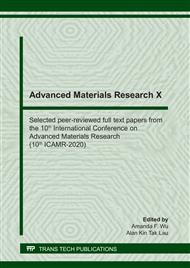[1]
Stephen Malkin, Changsheng Guo: Grinding technology - theory and applications of machining with abrasives – Second editor (Industrial Press, New Yourk 2008).
Google Scholar
[2]
Triratna Shrestha, Sultan F. Alsagabi, Indrajit Charit, Gabriel P. Potirniche and Michael V. Glazoff, in: Effect of Heat Treatment on Microstructure and Hardness of Grade 91 Steel, Metals, Vol. 5, pp.131-149 (2015).
DOI: 10.3390/met5010131
Google Scholar
[3]
[Balwinder Singh and Balwant Singh, in: Effect of Process Parameters on Micro Hardness of Mild Steel Processed by Surface Grinding Process, IOSR Journal of Mechanical and Civil Engineering, Volume 10, Issue 6, pp.61-65 (2014).
DOI: 10.9790/1684-1066165
Google Scholar
[4]
Liu Judong, Yuan Wei, Huang Songwei and Xu Zhilong, in: Experimental Study on Grinding-hardening of 1060 Steel, Energy Procedia 16, pp.103-108 (2012).
DOI: 10.1016/j.egypro.2012.01.019
Google Scholar
[5]
Marcelo Oliveira Gomes, Luiz Mauricio Gonçalves Neto, Robson Bruno Dutra Pereira, Carlos Henrique Lauro and Lincoln Cardoso Brandão, in: Influence of cutting parameters on surface hardening of 52100 steel in flat grinding process, The International Journal of Advanced Manufacturing Technology, Vol. 96, p.751–764 (2018).
DOI: 10.1007/s00170-018-1656-z
Google Scholar
[6]
Azhar Thanedar, Panchakshari Hiremath and Rajkumar Singh, in: Investigation of Surface hardness, bearing ratio and roundness for microalloyed steel during Cylindrical Plunge Grinding, nternational Journal of Latest Research in Engineering and Technology, Vol. 3, Iss. 4, pp.31-36 (2017).
Google Scholar
[7]
Mohanad Muzahem Khalaf, V. Kostyk, Demin and K. Kostyk, in: MODELING OF THE CASE DEPTH AND SURFACE HARDNESS OF STEEL DURING ION NITRIDING, Восточно-Европейский журнал передовых технологий, Vol. 80. Pp.45-49 (2016).
DOI: 10.15587/1729-4061.2016.65454
Google Scholar
[8]
M.F. Ashby and K.E. Easterling, in: The transformation hardening of steel surfaces by laser beams—I. Hypo-eutectoid steels, Acta Metallurgica (1984).
DOI: 10.1016/0001-6160(84)90175-5
Google Scholar
[9]
R. Liu, M. Salahshoor, S. N. Melkote and T. Marusich, in: The prediction of machined surface hardness using a new physics-based material model, Procedia CIRP 13, pp.249-256 (2014).
DOI: 10.1016/j.procir.2014.04.043
Google Scholar
[10]
J. Trzaska, in: Calculation of the steel hardness after continuous cooling, Archivers of materials Scince and engineering, Volume 61, Issure 2, pp.87-92, (2013).
Google Scholar
[11]
J.V. Fernandes, A.C. Trindade, L.F. Menezes and A. Cavaleiro, in: A model for coated surface hardness, Surface and Coatings Technology 13, pp.457-461 (2000).
DOI: 10.1016/s0257-8972(00)00839-2
Google Scholar
[12]
O. B. Fedoseev and S. Malkin, in: Analysis of Tempering and Rehardening for Grinding of Hardened Steels, Transactions of the ASME, Vol. 113, pp.388-394 (1991).
DOI: 10.1115/1.2899712
Google Scholar
[13]
https://steelnavigator.ovako.com/steel-navigator/heat-treatment/.
Google Scholar
[14]
Do Duc Trung, Nguyen Van Thien, Hoang Tien Dung and Tran Quoc Hung, in: A Study on Calculating Grinding Temperature, Lecture Notes in Networks and Systems 63 - Advances in Engineering Research and Application, p.84–90 (2019).
DOI: 10.1007/978-3-030-04792-4_13
Google Scholar
[15]
Malkin S. and Anderson R. B., in: Thermal Aspects of Grinding, Part 1 – Energy Partition, Trans. ASME, J. of Eng. for Ind., 96, p.1177 (1974).
DOI: 10.1115/1.3438492
Google Scholar
[16]
Sato K., in:, Grinding Temperature, Bull. Japan Soc. Grind. Engns., 1, p.31 (1961).
Google Scholar
[17]
https://en.wikipedia.org/wiki/Thermal_diffusivity.
Google Scholar
[18]
Roger Singleton: Utilisation of chip thicknes moedels in grinding (Phd Thesis, The University of Sheffield 2012).
Google Scholar
[19]
M.C. Shaw: Principles of Abrasive Processing (Oxford University Press, Walton Street, Oxford 1996).
Google Scholar
[20]
Hockin HKX, Jahanmir S and Ives LK, in: Effect of grinding on strength of tetragonal zirconia and zirconia-toughened alumina. Mach Sci Technol 1, p.49–66 (1997).
DOI: 10.1080/10940349708945637
Google Scholar
[21]
J.E. Mayer and G.P. Fang, in: Effect of grit depth of cut on strength of ground ceramics, Annals CIRP. 43. pp.309-312 (1994).
DOI: 10.1016/s0007-8506(07)62220-3
Google Scholar
[22]
Ping Zhang and Michele H. Miller, in: Grinding Wheel Condition Prediction and Improvement, Michigan Technological University, Houghton, MI (2012).
Google Scholar
[23]
Do Duc Trung, Nguyen Van Thien and Hoang Tien Dung, in: Predictive Surface Roughness of Workpiece in Surface Grinding, American Journal of Materials Research, 4(6), pp.37-41 (2017).
Google Scholar
[24]
Hamid Reza FAZLI SHAHRI, Ali Akbar AKBARI, Ramezanali MAHDAVINEJAD and Ali SOLATI, in: Surface hardness improvement in surface grinding process using combined Taguchi method and regression analysis, Journal of Advanced Mechanical Design, Systems, and Manufacturing, Vol.12, No.2, pp.1-14 (2018).
DOI: 10.1299/jamdsm.2018jamdsm0049
Google Scholar


